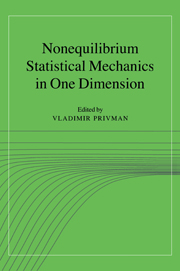Book contents
- Frontmatter
- Contents
- Contributors
- Preface
- Part I Reaction-Diffusion Systems and Models of Catalysis
- Part II Kinetic Ising Models
- Part III Ordering, Coagulation, Phase Separation
- Part IV Random Adsorption and Relaxation Processes
- Part V Fluctuations in Particle and Surface Systems
- 13 Microscopic models of macroscopic shocks
- 14 The asymmetric exclusion model: exact results through a matrix approach
- 15 Nonequilibrium surface dynamics with volume conservation
- 16 Directed-walk models of polymers and wetting
- Part VI Diffusion and Transport in One Dimension
- Part VII Experimental Results
- Index
- Abbreviations
16 - Directed-walk models of polymers and wetting
Published online by Cambridge University Press: 18 December 2009
- Frontmatter
- Contents
- Contributors
- Preface
- Part I Reaction-Diffusion Systems and Models of Catalysis
- Part II Kinetic Ising Models
- Part III Ordering, Coagulation, Phase Separation
- Part IV Random Adsorption and Relaxation Processes
- Part V Fluctuations in Particle and Surface Systems
- 13 Microscopic models of macroscopic shocks
- 14 The asymmetric exclusion model: exact results through a matrix approach
- 15 Nonequilibrium surface dynamics with volume conservation
- 16 Directed-walk models of polymers and wetting
- Part VI Diffusion and Transport in One Dimension
- Part VII Experimental Results
- Index
- Abbreviations
Summary
The aim of this chapter is to summarize briefly recent results on directed walks and provide a guide to the literature. We shall restrict consideration to the equilibrium properties of directed interfaces and polymers, focusing particularly on their collapse and binding transitions. The walks will lie in a nonrandom environment.
Directed walks and polymers
A clear introduction to the physics of directed walks is given by Privman and Švrakić in a book published in 1989. This summarizes the work up to that time and therefore here we shall aim to describe more recent progress after a brief description of the relevant models.
Many of the interesting results for nonrandom systems have been obtained for walks that should strictly be labeled partially directed. In these movement is allowed along either the positive or negative x-direction but only along the positive t-direction, as shown in Fig. 16.1. Hence the position ratof the walk in column t= i is unique.
Also shown in Fig. 16.1 for comparison is a fully directed walk, each step of which must have a nonzero component in the positive t-direction. This is a simpler model, which has been very useful in studying the behavior of interfaces in a random environment (not reviewed here; see). The partially directed walk reduces to the fully directed one if the constraint is imposed.
- Type
- Chapter
- Information
- Nonequilibrium Statistical Mechanics in One Dimension , pp. 329 - 334Publisher: Cambridge University PressPrint publication year: 1997



